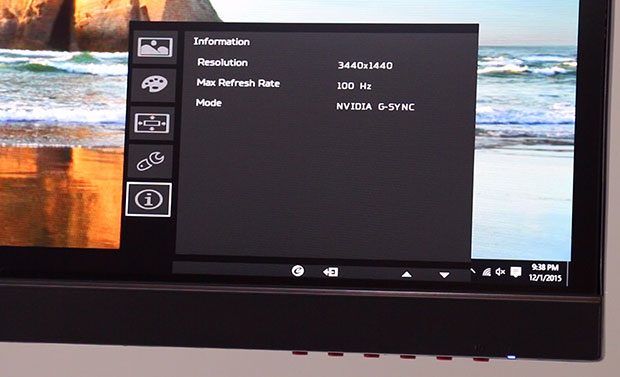Many monitors that offer
overclocking capability for a higher refresh rate are typically setup at 60Hz out of the box and if you want that higher refresh rate you have to overclock it in your graphics drivers, potentially overriding the display configuration of the monitor. However, the Acer Predator X34 has the option of hard-setting your refresh rate in its on-screen display settings area. Select that config and after a quick reboot, you'll have that higher refresh rate in your driver control panel to select from.


It makes the whole process that much easier and since the panel has this setting available out of the box from the factory, it's fully warrantied, which instills confidence that you're not pushing the envelope in any way. Also, as you can see, the panel automatically shows as G-SYNC capable and that setting is ready to go out of the box as well with no configuration required. We have a number of articles covering NVIDIA G-SYNC technology at HotHardware but
Marco steps through it well here if you'd like a refresher. In short, when enabled, a
G-SYNC capable panel updates pixels precisely synchronized with the frames rendered by the GPU, which completely eliminates any tearing artifacts, jitter and wander that you can sometimes see while gaming if Vsync is not enabled. Even with Vsync enabled, you can’t match the perfect smoothness and clarity of gaming with a G-SYNC enabled monitor like the Acer Predator X34. We'll give you more detail on gaming with this beast shortly. For now, let's look at panel performance and accuracy.
Brightness, Contrast, Gradient And Pixel Response
For some of our testing we used the Lagom LCD monitor test pages found at http://www.lagom.nl/lcd-test/. The Lagom LCD monitor test pages provide tests for saturation, banding, sharpness, uniformity and more. We also used this online monitor testing page at FlatpanelsDK - http://tft.vanity.dk/monitorTest_scale.html which dives deeper into gradient response and even pixel alignment.
We didn’t have any professional grade equipment on hand, but these few online test and our colorimeter definitely helped us dial things in with the Predator X34 and assess performance as well. The panel is reasonably bright, offering plenty of pop for just about any indoor environment. The Predator X34's saturation out of the box is punchy as well and actually we found ourselves taming it down a bit in the settings control panel. There’s a high degree of adjustability here so it wasn’t an issue. Contrast settings were easily controlled and we found ourselves shying away from the adaptive contrast functionality in favor of locking things down. Color uniformity is also excellent across the screen with good continuity from edge to edge.


Gradient response was also solid and there was no problem with
dialing gamma settings to a spot where a full spectrum was visible with
2% step increments for both dark and light shades. We did however notice
just a touch of backlight bleed at the corners of the display and along
the top edge of our panel. We had to really drop studio
lighting to see this prominently and in practice, for most environments,
you’re not going to notice it. It was a complete non-issue for the panel we tested, actually. Finally, we've seen some reports of scanline issues with the 100Hz setting and this version of the Predator X34, however that was not something we observed in testing. All told, our panel offered near perfect, trouble-free performance and delivered brightness, saturation, color and contrast response that was in line its specifications and Acer's 100% sRGB claim.









